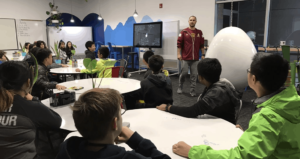13 Barriers to Education Innovation

All established organizations struggle with innovations that fundamentally challenge their status quo. That struggle is the focus on nonprofit think tank Clayton Christensen Institute for Disruptive Innovation. Cofounder Michael Horn said, “These struggles aren’t unique to education. Businesses struggle consistently with the innovator’s dilemma—the ability to prioritize disruptive innovations that would cannibalize their existing business,” adding that organizations usually lock in on a business model consisting of four elements, including value proposition, resources, processes and revenue formula. “These four components help define an organization’s capabilities but also—and perhaps most importantly—what it is not capable of doing,” said Horn.
Where innovation happens, how it spreads, and what gets in the way–these are the questions that drove the the two year investigation that resulted in our new book, Smart Cities That Work for Everyone.
Building on five barriers that Michael Horn identified, here are 13 barriers that schools face to innovation:
- Changes in leadership. Because district and political leadership can shift often, pursuing, refining and staying the course with an innovation that will take some time to implement, let alone perfect, can be difficult. This leads to a “this too shall pass” mentality. LAUSD is just the last frustrating example.
- Little autonomy. In many cases, for political reasons school districts are unable to create a new and autonomous business model, but research shows that doing this is often critical to solving the innovator’s dilemma.
- Little non-consumption of schooling. Nearly everyone has access to what appears to be a free schooling option—there is less room to innovate.
- Critical role. Historically communities have been unwilling to let schools fail because of how important their role is from a social perspective in the community. Parents and communities have not been risk tolerant.
- Varied stakeholders. Public school districts serve an unusually high number of stakeholders with different jobs to be done in an intricately interdependent system. This makes it difficult for new innovations to be accepted without significant modification to meet the diverse needs of such a complicated ecosystem.
- Strong constraints. State and federal policy create a pretty confined space: standards influence aims, tests monopolize time, and funding is input-based and programmatic. Local contracts are often ensconced in board policies and state laws creating a Gordian knot of constraints that requires several waivers or changes before doing anything different. Some districts are pushing more budget and accountability to school principals, but few of them have any experience in organizational design, or what Rick Hess calls cage-busting leadership.
- Weak incentives. There are relatively weak performance incentives in education. Some recently implemented evaluation and accountability systems have ratcheted up stakes but usually around narrowly defined and crudely measured outcomes. In highly competitive sectors, prize mechanisms often lead to product and service innovations. There are weak scaling incentives for nonprofits and government agencies—more customers may simply mean more headaches. The lack of scale incentives like performance pay and equity means it is harder to attract talent and encourage growth. Schools have little capacity or incentive to make productivity- improving capital investments and, as a result, there are few efficiency innovations.
- Little R&D. Compared to other sectors, there is far less spent on education research and development. The U.S. invests only 0.2% of its education budget on R&D versus the top tech companies that routinely spend more than 10 percent. Despite the impact potential, there is far less spent on learning sciences than other areas of fundamental research. Much of the research undertaken in higher education is focused in arcane subjects driven by doctoral committees rather than any attempt to prioritize by potential impact. The good news is that venture investors will invest over $1 billion in education startups this year.
- Low sharing. Education has a way of isolating teachers and turning them into individual practitioners. The lack of support and direction leads to an insular culture that reduces outside influences, as well as structures that reduce permeation. The growth of personal learning communities is beginning to break down isolation.
- Little capacity. There is very little change capacity in schools, districts or state offices. It is tough to balance improvement and innovation simultaneously. Schools simply were not designed to innovate. To the extent that they reflect intentionality, public delivery systems support equity and continuity. But the shift to digital and competency-based learning requires a lot of innovation and change capacity.
- High complexity. Supporting the development of diverse young people is complex work. Learning, especially for children, is and will remain a distinctly a relationship- based enterprise, so organizational design and development will remain more important than education technology, though most breakthroughs will combine both.
- Local control. A highly decentralized system of local control and weak improvement incentives dampens innovation diffusion. Highly effective school models are ignored, productive tools go unused, and community assets are underutilized. “While education struggles to innovate, our kids can’t wait,” said Abby Andrietsch. “We want meaningful system-wide change, but our kids just can’t wait for top-down, systemic reform.” Andrietsch, a tireless advocate for kids, directs Schools That Can Milwaukee, which set a goal of creating high-performing schools serving more than 20,000 students. On barriers, she notes, “Well-meaning policy efforts are too often mired in political gamesmanship and reduced to little more than incremental improvements.”
- Mindset. Andrietsch argues not only for a more responsive form of local governance, but for a whatever-it-takes mindset—as opposed to the compliance mindset demanded by local, state and federal education policy. This compliance mindset may be the biggest barrier to innovation—and it runs headlong into the current context of American cities. “Schools now find themselves struggling to play catch-up as the economy continues to morph with dizzying speed and unpredictability,” said college and career readiness expert David Conley. “Success in the economy and society of the future will be much more a function not simply of what people have learned but of what they are capable of learning.” Conley adds that creating lifelong learners will become an increasingly critical and compelling goal of education.
If educators are to prepare young people for the innovation economy, they will need an innovation mindset. “To drive lifelong learning and the success of students early on, we must foster an environment where students learn at their own pace in an encouraging environment that cultivates a deep conceptual understanding of subject matter,” said Jessie Woolley-Wilson, DreamBox Learning President and CEO. “When students develop a deep understanding of concepts, they can apply and transfer that learning to new situations and experience success again and again.” Jessie calls this critical thinking and adaptability “nimble intelligence.” Creating the learning opportunities that develop mental agility in young people begins with ecosystems that encourage educators to be innovators rather than compliance monitors. With more innovators and edupreneurs, the barriers won’t last for long.
For more, see:
- The Path to Systemic Innovation (Sir Michael Barber)
- A Dozen Reasons Education Can’t Innovate; A Dozen Ways That’s Changing
- 10 Ways Independent Schools Could Lead on Innovation
- 12 Education Innovation Mindsets for Leaders
DreamBox Learning is a Getting Smart Advocacy Partner.





Midway
Come visit us at Midway! You might change your mind about this.